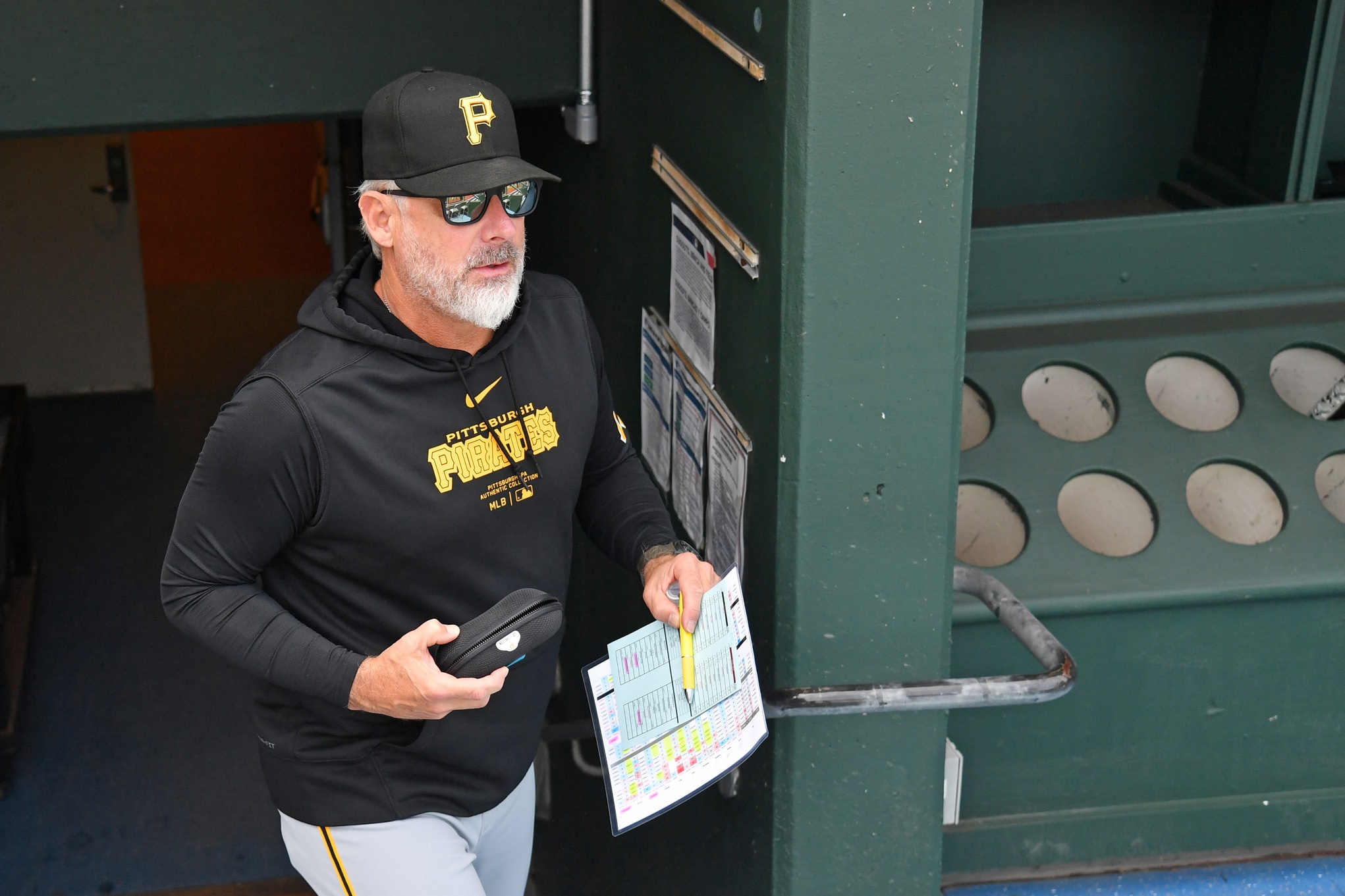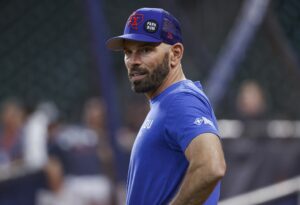One common criticism of Pittsburgh Pirates manager Derek Shelton is his unwillingness to stick with a set lineup every day. The Pirates offense has been pathetic lately and is a chief reason why they’re 5-16 in their last 21 games. Pirates batters are hitless in their last 16 at-bats with runners in scoring position. To borrow a phrase the legendary Pittsburgh Steelers coach Chuck Noll once said of his troubled defensive lineman Ernie Holmes, Shelton has problems, and they are many. However, the use of a set lineup won’t solve them.
Pirates started 20-8 last year. Proceeded to go 5-16. Were 25-24 after 49 GP.
This year, started 9-2. In the middle of another 5-16 skid. Currently 14-18.
Then again, they had two 5-17 stretches in ’22.
So much for shortening long losing periods.
— Jason Mackey (@JMackeyPG) May 2, 2024
So far in 2024, Shelton has used 31 different lineups in 32 games. The most commonly used lineup has been employed just twice. In 2023, en route to a 76-86 record, Shelton used 157 lineups, with the most common lineup used twice. He’s been taken to task on social media and talk shows for changing his batting order on a daily basis. As it turns out, there is no correlation between winning and using a set lineup for every game. Let’s start by discussing some teams with which Pirates fans should be familiar.
Shelton Using Set Lineup Won’t Solve Pirates’ Problems
The Best Pirates Team?
Shelton has company in Bill Virdon, another Pirates manager who didn’t employ a set lineup. In 1972, Virdon wrote 117 different batting orders (not counting pitchers) on his lineup cards. This was necessitated by several factors. Willie Stargell was used at first base because his balky knees needed a break from the rigors of patrolling left field on the artificial turf of Three Rivers Stadium. Roberto Clemente was frequently injured. Thus, Virdon used several players to man the corner outfield spots, depending on matchups.
Young infielders Dave Cash and Richie Hebner missed long stretches for military duty. Virdon had trouble settling on a shortstop between banged-up Gene Alley and error-prone Jackie Hernández. Yet there were no complaints about the lack of a set lineup. The 1972 Pirates finished 96-59 in a strike-shortened season. That postseason, they were just one Dave Giusti blown save away from a second straight World Series appearance. Many feel that this was the best team in Pirates history.
Shelton in Good Company
Pirates fans might be comforted (or on second thought, probably not) to know that there were two Hall of Fame managers who, like Shelton, had a proclivity to eschew a daily set lineup.
The 1979 Baltimore Orioles, who lost to the Pirates in the World Series, used 140 different batting orders on their way to a 102-57 regular season. Manager Earl Weaver never used a lineup more than three times in 1979. He platooned heavily and based his lineups on matchups. He had an uncanny knack for picking the right batters against the right opposing pitchers. Nobody called it analytics back then, but that probably described what he was doing. Even in the World Series, only third baseman Doug DeCinces, first baseman Eddie Murray, and right fielder Ken Singleton were constants. Weaver started two catchers, two second basemen, two shortstops, three left fielders, and two center fielders in the seven games.
Even the legendary Casey Stengel, who managed the 1960 New York Yankees that faced the Bucs in the 1960 World Series, changed his lineups frequently. That year, he used 109 different batting orders, excluding pitchers, and never one for more than five games. In the Series, Stengel used a different batting order in each of the seven games. He started three catchers, two third basemen, and three left fielders. This included Yogi Berra, who started at both catcher and left field. The varied lineups didn’t prevent the Yankees from setting several offensive World Series records. As a team, they batted .338/.383/.528 with ten home runs in losing the Series.
Fast Forward to 2023
Having noted the extent to which Shelton and the Pirates used a set lineup in 2023, let’s look at how other teams did it. A crack research team (me) examined each major league team’s batting orders in 2023 and made some interesting findings. Only the Kansas City Royals used more lineups than the Pirates with 158. The Atlanta Braves had the best record in baseball at 104-58 and used just 80 different lineups. The Braves sent in the same lineup card a major league-high 21 times. The Los Angeles Dodgers at 100-62 used 132 lineups, and none more frequently than 13 times. None of this is surprising, however. The Braves and Dodgers have superstar-laden lineups and don’t need many changes. On the other hand, baseball’s second-winningest team, the Orioles at 101-61, used 150 lineups. The Orioles’ most common lineup was used only five times.
If each team is listed from the best record to the worst in 2023, one finds that five playoff teams finished in the top half of the majors in most lineups used, and the other seven finished in the bottom half. The Tampa Bay Rays were 99-63 and used 152 lineups, never using any one lineup more than twice. The Minnesota Twins, who finished 87-75, used 156 lineups, none more than three times. Shelton was the Twins bench coach under manager Rocco Baldelli before taking the job as the Pirates skipper.
The Braves and Dodgers are clear outliers in this analysis. As for the other 28 teams, four teams’ most common lineup was used twice, and four teams’ most common lineup was used seven times. The remaining 20 teams fell somewhere within that range. There was no correlation between a set batting order and winning in 2023.
Modern Batting Order Construction
The batting orders of Shelton, and his discounting of the purported value of a set lineup for his Pirates, are informed by analytics. Gone are the days of the base-stealing threat with the low OBP in the leadoff spot and the No. 2 hitter who makes so-called productive outs. The Nos. 1, 2, and 4 spots are the new 3, 4, and 5 spots. As explained in The Book: Playing the Percentages in Baseball by Tom Tango, Michael Lichtman, and Andrew Dolphin:
Your three best hitters should bat somewhere in the #1, #2 and #4 slots. Your fourth- and fifth-best hitters should occupy the #3 and #5 slots. The #1 and #2 slots will have players with more walks than those in the #4 and #5 slots. From slot #6 through #9, put the players in descending order of quality.
This raises a few questions. Who are a team’s three best hitters? Who are the fourth- and fifth-best? Are these determinations made based on who the team’s best overall hitters are over a long season? Or the best hitters against that particular pitcher? Does it take into account who’s hot lately? The answers may account for why Shelton and so many other managers change lineups so frequently throughout the season.
Billy’s Hat Trick
In 1968, minor league manager Billy Martin was persuaded by his struggling Denver team to make up the batting order by pulling the names out of a hat. Martin tried it and Denver won, 8-7. By 1972, Martin was managing the Detroit Tigers. It was August 13. Martin’s Tigers had lost 10 of their last 13 and fell out of first place. With the Cleveland Indians in town for a doubleheader, Martin again pulled the names out of a hat for game one. The only exception was that his pitcher would bat ninth. Lumbering first baseman Norm Cash was in the leadoff spot. The cleanup hitter was light-hitting shortstop Ed Brinkman. Protecting Brinkman in the fifth spot was diminutive second baseman Tony Taylor.
The Tigers beat the Indians and Gaylord Perry, 3-2. Brinkman drove in the tying run with a double and scored the winning run on Taylor’s single. Martin went back to a more conventional batting order for game two. The Indians won that one, 9-2.
Martin would return to this tactic again in 1977 as manager of the Yankees. His talented club began the season by losing eight of its first 10. Ordinarily, that wouldn’t be cause for panic, except these were the Yankees of impatient, meddlesome owner George Steinbrenner. On April 20 against the Toronto Blue Jays, Martin went back to the hat. He had power-hitting first baseman Chris Chambliss batting eighth. The fifth and sixth spots were occupied by singles hitters Mickey Rivers and Roy White. The Yankees won, 7-5. Martin kept that batting order, with some tweaks, for six more games. After five more wins in a row, the Yankees lost and Martin returned to a more normal batting order. All told, Martin’s teams were 8-1 when he employed his “hat trick.”
The Last Word
None of this is to absolve Shelton of any blame for the Pirates’ recent struggles. The front office, manager, coaches, and players alike should share the blame for any failures. But to blame the problems of the Pirates on Shelton for not sticking to a set lineup? There’s enough statistical and anecdotal evidence to refute that notion.
Photo Credit: © Eric Hartline-USA TODAY Sports






